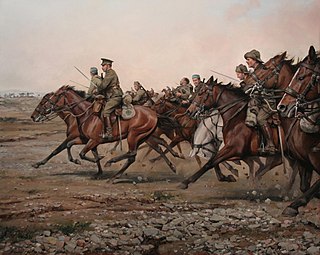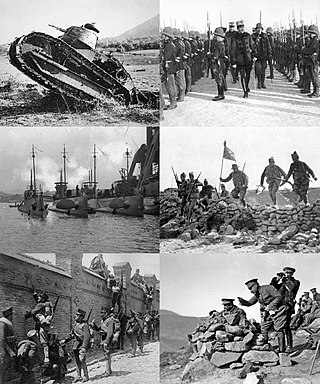Notes and references
- ↑ Protests (in French) Archived July 21, 2006, at the Wayback Machine
Ameziane museum is a private museum opened in Nador, Morocco in May 2006.
The museum prompted controversy as it is dedicated to Maréchal Mohamed Ameziane, a former military chief of staff during the Third Rif War in early 20th century whom many believe helped the Spanish army in the Rif region of Spanish Morocco against the guerrilla revolutionary Abd el-Krim. [1]
Berber people in Rif region have been awaiting instead for a museum dedicated to Abd el-Krim or at least bring the remains of him from Cairo, Egypt, where he died in asylum in 1963.

Muhammad ibn Abd al-Karim al-Khattabi, better known as Abd el-Krim was a Moroccan political and military leader and the President of the Republic of the Rif. He and his brother M'Hammad led a large-scale revolt by a coalition of Riffian tribes against French and Spanish colonization of the Rif, in Morocco. His guerrilla tactics, which included the first-ever use of tunneling as a technique of modern warfare, directly influenced Ho Chi Minh, Mao Zedong and Che Guevara.
The Government of the Republic of the Rif was established on 18 September 1921 when the Riffian Tribes, led by Abd el-Krim, beat Spain in the Battle of Annual during the Rif War and created the Confederal Republic of the Tribes of the Rif.

The Battle of Annual was fought on 22 July 1921 at Annual, in northeastern Morocco, between the Spanish Army and Rifian Berbers during the Rif War. The Spanish suffered a major military defeat, which is almost always referred to by the Spanish as the Disaster of Annual which is widely considered to be the worst defeat suffered by the modern Spanish Army.

The Spanish protectorate in Morocco was established on 27 November 1912 by a treaty between France and Spain that converted the Spanish sphere of influence in Morocco into a formal protectorate.

The Republic of the Rif, officially The Rifian People's Democratic Republic, also known simply as the Rif, was a confederate republic in the Rif, a region in northern Morocco, that existed between 1921 and 1926. It was created in September 1921, when the local people of the area revolted, declaring their independence from Spanish colonization, as well as from Sultan Yusef. The French would intervene on the side of Spain in the later stages of the conflict. The Rif was the last sovereign republic in Morocco to date. A protracted struggle for independence killed many Riffians and Spanish–French soldiers, and witnessed the use of chemical weapons by the Spanish army—their first widespread deployment since the end of the Great War. The eventual Spanish–French victory was owed to the technological and manpower advantages enjoyed by the colonizers, in spite of their lack of morale and coherence. Following the war's end, the Rif Republic was ultimately dissolved in 1926.

The Rif or Riff, also called Rif Mountains, is a geographic region in northern Morocco. This mountainous and fertile area is bordered by Cape Spartel and Tangier to the west, by Berkane and the Moulouya River to the east, by the Mediterranean to the north, and by the Ouergha River to the south. The Rif mountains are separated into the eastern Rif mountains and western Rif mountains.

Morocco, currently a monarchy, has known some attempts to establish republican forms of government. Some of those attempts are continuing to this day:
Temsaman is a region located in the Rif, northeast of Morocco. Temsamane is the main city in the region. The center of the province is Kerouna. The province of Temsaman includes smaller villages such as: Boudinar, Amezarou, Ajdir, Takseft n Dhar, Budinar, and Icniwen.

The Rif War was an armed conflict fought from 1921 to 1926 between the occupying colonialists of Spain and the Berber tribes of the mountainous Rif region of northern Morocco.
The Ait Ouriaghel is one of the biggest Riffian tribes of the Rif region of the north-eastern part of Morocco and one of the most populous. Ait Waryagher means "those who do not back off/ those who do not retreat". They inhabit most of the territory around the city of Al Hoceima. The Ayt Waryaghar speak the "Western-Tarifit" dialect of the Riffian language.

Amghar Mohammed Ameziane, Prince of the Rif was a leader of the Riffian resistance against the Spanish occupation of Northern Morocco and last Tribal Monarch until his death in 1912, where President Abd el-Krim. He is the great-great-grandfather of Massinissa of the Rif.

Mulai Ahmed er Raisuni was a Sharif, and a leader of the Jebala tribal confederacy in Morocco at the turn of the 20th century. While he was regarded by foreigners and the Moroccan government as a brigand, some Moroccans, especially among the Jebala, considered him a heroic figure, fighting a repressive, corrupt government, while others considered him a thief. Historian David S. Woolman referred to Raisuni as "a combination Robin Hood, feudal baron, and tyrannical bandit." He was considered by many as "The last of the Barbary Pirates" though Barbary Coast piracy had ended by the middle of the 19th century. On the other hand, according to Douglas Porch, an American historian, Raisuni was part of the rule rather than the exception in that every successful Moroccan politician at the time combined villainy with sainthood. He died in April 1925 after having been captured and imprisoned by his rival Abd el Krim.
During the Third Rif War in Spanish Morocco between 1921 and 1927, the Spanish Army of Africa deployed chemical weapons in an attempt to put down the Berber rebellion against colonial rule in the region of Rif led by the guerrilla Abd el-Krim. Following the humiliation at the Battle of Annual in 1921, considered as the worst Spanish defeat in the 20th-century, the Spanish army pursued a vicious campaign of retribution involving the indiscriminate and routine dropping of toxic gas bombs targeting civilian populations, markets and rivers.
Riffians or Rifians are a Berber ethnic group originally from the Rif region of northeastern Morocco. Communities of Riffian immigrants are also found in southern Spain, Netherlands and Belgium as well as elsewhere in Western Europe. They are overwhelmingly Sunni Muslims, but retain their pre-Islamic traditions such as high status for Riffian women.

Francisco Gómez-Jordana y Sousa, 1st Count de Jordana, was a Spanish soldier and politician who served as Minister of Foreign Affairs during the rule of Francisco Franco.

The Alhucemas landing was a landing operation which took place on 8 September 1925 at Alhucemas by the Spanish Army and Navy and, in lesser numbers, an allied French naval and aerial contingent, that would put an end to the Rif War. It is considered the first amphibious landing in history involving the use of tanks and massive seaborne air support. Alhucemas is seen as a precursor of the Allied amphibious landings in World War II, and the first successful combined operation of the 20th century.
’Mohammed Lhaj Slam Amzian' was a Moroccan politician, a member of the Democratic Independence Party and a veteran of the pre-independence guerilla Army of Liberation. He led the Rif Revolt (1958-1959).
1958 Rif riots, Rif Revolt or Rif uprising took place in the northern Rif region of Morocco by tribes rebelling against the Moroccan government, motivated by the region's marginalization. The revolt, led by Sellam Amezian, had a clear set of demands: political and social rights, the departure of foreign troops from the country, the return of the resistance leader Abd el-Krim from exile, the dissolution of political parties, the liberation of political prisoners, and the installation of a "people's government". The coups and protests aimed at overthrowing the monarchy of the sultan and king Mohammed V of Morocco and his Alaouite dynasty in Morocco and forming a democratic republic
Anarchism in Morocco has its roots in the federalism practiced by Amazigh communities in pre-colonial Morocco. During the Spanish Civil War, Moroccan nationalists formed connections with Spanish anarchists in an attempt to ignite a war of national liberation against Spanish colonialism, but this effort was not successful. Despite the brief establishment of an anarchist movement in post-war Morocco, the movement was suppressed by the newly independent government, before finally reemerging in the 21st century.

Massinissa, known by his courtesy title as Sidi Massinissa of the Rif, is a Moroccan-born Riffian indigenous social entrepreneur. He is the great-great-grandson of Amghar Mohand Ameziane, Prince of the Rif the last Tribal Monarch of the Rif and first anti-colonial leader of Morocco.